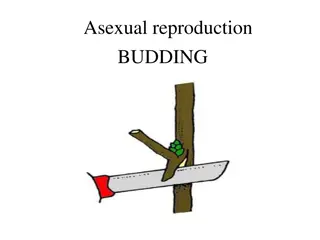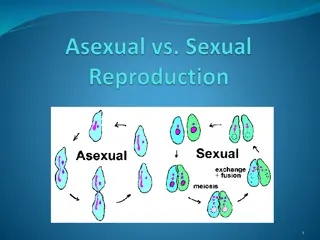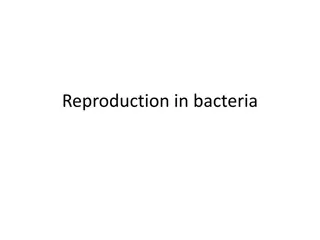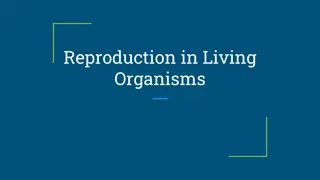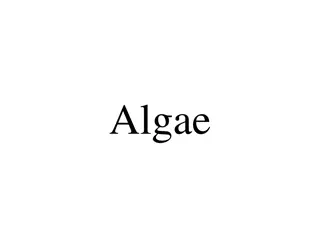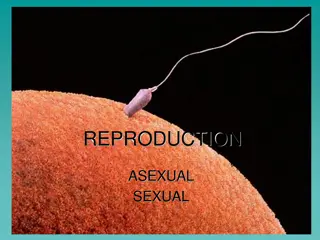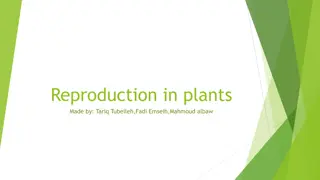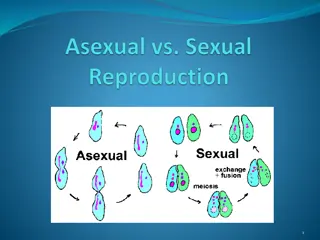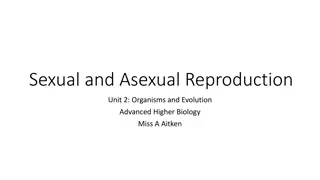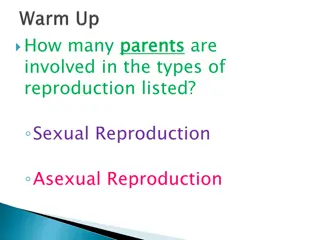Reproduction in Organisms: A Comparison of Sexual and Asexual Methods
Reproduction in organisms involves two main methods - sexual and asexual. In sexual reproduction, two parents contribute genetic information, leading to unique offspring, while asexual reproduction involves a single parent producing genetically identical offspring. This article explores the differences in complexity, parental contributions, and genetic outcomes between sexual and asexual reproduction.
Download Presentation

Please find below an Image/Link to download the presentation.
The content on the website is provided AS IS for your information and personal use only. It may not be sold, licensed, or shared on other websites without obtaining consent from the author. Download presentation by click this link. If you encounter any issues during the download, it is possible that the publisher has removed the file from their server.
E N D
Presentation Transcript
body cells DNA in body cells is not passed to offspring Body cells contain pairs of chromosomes Human body cells have 23 pairs, or 46 individual chromosomes The Cell Cycle from Chapter 5 applies to Body Cells
Gametes are sex cells In the female, gametes are ova (eggs) In the male, gametes are sperm cells Gametes do not have pairs of chromosomes The human gamete has 23 individual chromosomes The DNA in gametes is passed to offspring
The creation of an offspring from a single parent Does not involve the fusion of gametes Offspring are usually genetically identical to each other and to the single parent
See Asexual Reproduction video on Blendspace
Involves the joining of gametes (eggs and sperm cells) one from each of two parents Offspring produced are a genetic mixture of both parents Internal fertilization of eggs by sperm increases chance of gametes meeting fewer gametes may be produced If eggs and sperm are released outside the body, gametes may not meet. Organisms must produce many gametes.
RELATIVE COMPLEXITY OF ORGANISMS Sexual Complex, larger organisms tend to reproduce sexually Asexual Simple, smaller organisms tend to reproduce asexually
NUMBER OF PARENTS CONTRIBUTING GENETIC INFORMATION TO OFFSPRING Sexual Two parents contribute genetic information Offspring have a combination of genetic information from their parents Offspring are unique from their parents and other offspring Asexual One parent contributes genetic information Offspring are exact copies (clones) of the parents
REPRODUCTIVE MECHANISM Sexual Involves the fusion of gametes from two parents Asexual Does not involve gametes Reproduction is by splitting in half, or forming new individuals that are released fro the parent
RELATIVE AMOUNT OF PARENTAL CARE Sexual Organisms tend to have longer gestation periods and developing offspring are protected Organisms tend to care for their young, increasing chance of survival Organisms that invest time and energy in caring for their young tend to have fewer offspring Some sexually reproducing organisms do not gestate or care for their young in these cases, large numbers of gametes or offspring are produced, which helps to offset the death rate of offspring
RELATIVE AMOUNT OF PARENTAL CARE, cont. Asexual Organisms tend to have little or no parental are Organisms that do not care for their young tend to produce large numbers of offspring Organisms may have large numbers of offspring when few offspring survive Organisms that split to produce an adult offspring often reproduce rapidly
GENETIC VARIATION OF OFFSPRING Sexual Genetic variation results from sexual reproduction genetic information from two parents combine Genetic variation helps a species (as a whole) survive. Organisms with slightly different traits due to genetic variation may have survival advantage. Asexual There is no genetic variation in offspring.
In a human body cell, there are 23 pairs of chrosomes 22 of these pairs are AUTOSOMES Autosomes that aren t directly related to the sex of an organism The 23rdpair are chromosomes known as SEX CHROMOSOMES. development of sexual characteristics. AUTOSOMES Autosomes are chromosomes that contain genes SEX CHROMOSOMES. These genes directly control the
There are two different sex chromosomes X Y An organism with two X chromosomes (XX) is FEMALE FEMALE An organism with one X and one Y chromosomes (XY) is MALE MALE
Haploid set of chromosomes In the human, this means there are 23 individual chromosomes. 22 are autosomes, 1 is a sex chromosome Haploid Cells, such as gametes, have only one Diploid have two sets (pairs). Diploid Cells, such as somatic cells (body cells)


